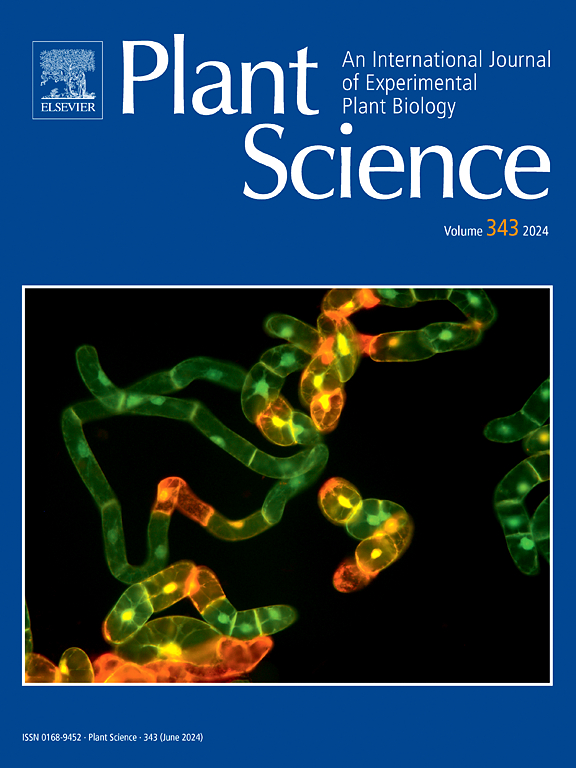油茶RALF基因家族的全基因组鉴定。以及CoRALF50在花粉管生长中的潜力。
IF 4.2
2区 生物学
Q2 BIOCHEMISTRY & MOLECULAR BIOLOGY
引用次数: 0
摘要
快速碱化因子(ralf)在授粉和受精过程中起着重要作用。然而,目前对山茶RALF家族的鉴定和研究还很缺乏,特别是对其在调节自交不亲和花粉管生长中的作用。本文从油茶基因组中鉴定出50个RALF基因,并将其分为3个类群:Ⅰ、Ⅱ和Ⅲ,分别包含11个、12个和27个成员。CoRALFs在染色体中的分布不均匀,片段重复事件主要促进了它们的扩增。基因结构和保守基序分析表明它们是高度保守的。顺式元件分析表明,在CoRALFs启动子中发现了许多光响应元件、胁迫响应元件和植物激素响应元件。此外,对花粉特异性CoRALF50的表达分析表明,CoRALF50对油桐自交不亲和花粉管的伸长和停滞有响应。进一步的实验表明,CoRALF50可以显著下调体外培养花粉管中碳水化合物代谢途径,从而导致ROS水平、质膜生物合成和细胞壁生物合成异常,证明了CoRALF50在调控花粉管生长中的重要作用。总之,本研究为探索ralf的新功能提供了新的信息,并为ralf在自交不亲和花粉管生长中的作用提供了新的见解。本文章由计算机程序翻译,如有差异,请以英文原文为准。
Genome-wide identification of the RALF gene family in Camellia oleifera Abel. and the potentiality of CoRALF50 in pollen tube growth
Rapid alkalinization factors (RALFs) play meaningful roles in the pollination and fertilization. However, the identification and study of Camellia RALFs is lacking, particularly the function of the RALF family in regulating self-incompatibility pollen tube growth. Herein, we identified 50 RALF genes from Camellia oleifera genome, and classified them into three groups: Clades Ⅰ, Ⅱ, and Ⅲ, with 11, 12, and 27 members being included, respectively. CoRALFs were unevenly distributed in chromosomes, and the segmental duplication events mainly facilitated their expansion. Gene structure and conserved motif analyses indicated that they were highly conserved. Cis-element analysis revealed that many light responsive elements, stress responsive elements and phytohormone responsive elements were found in CoRALFs promoters. Moreover, the expression analysis showed that pollen-specific CoRALF50 responded to the elongation and stagnation of self-incompatibility pollen tube in C. oleifera. Further experiments suggested that CoRALF50 could significantly down-regulate carbohydrate metabolism pathways in pollen tubes cultured in vitro, thereby causing abnormalities in ROS level, plasma membrane biosynthesis, and cell wall biosynthesis, which demonstrating the importance of CoRALF50 in regulating pollen tube growth. Altogether, this study extends information for exploring new functions of RALFs and provides new insights into the role of RALFs in self-incompatibility pollen tube growth.
求助全文
通过发布文献求助,成功后即可免费获取论文全文。
去求助
来源期刊

Plant Science
生物-生化与分子生物学
CiteScore
9.10
自引率
1.90%
发文量
322
审稿时长
33 days
期刊介绍:
Plant Science will publish in the minimum of time, research manuscripts as well as commissioned reviews and commentaries recommended by its referees in all areas of experimental plant biology with emphasis in the broad areas of genomics, proteomics, biochemistry (including enzymology), physiology, cell biology, development, genetics, functional plant breeding, systems biology and the interaction of plants with the environment.
Manuscripts for full consideration should be written concisely and essentially as a final report. The main criterion for publication is that the manuscript must contain original and significant insights that lead to a better understanding of fundamental plant biology. Papers centering on plant cell culture should be of interest to a wide audience and methods employed result in a substantial improvement over existing established techniques and approaches. Methods papers are welcome only when the technique(s) described is novel or provides a major advancement of established protocols.
 求助内容:
求助内容: 应助结果提醒方式:
应助结果提醒方式:


